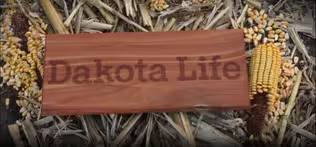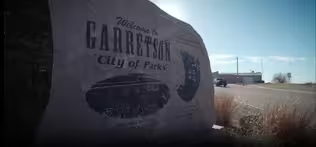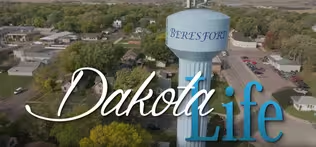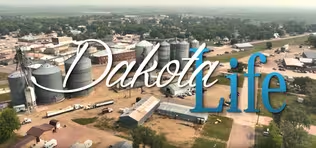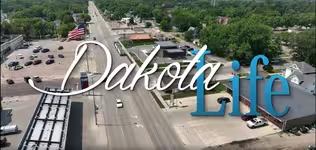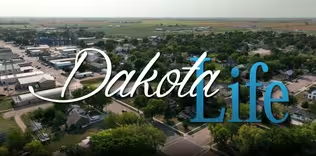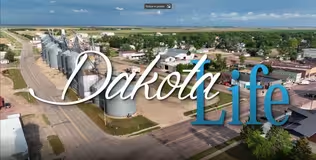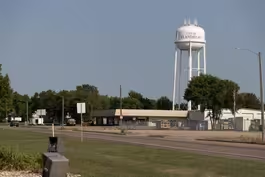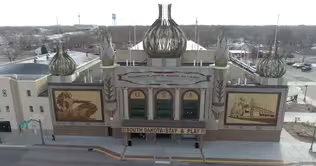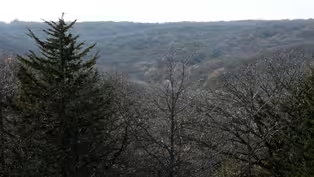Dakota Life
Greetings from Springfield
Season 24 Episode 4 | 28m 30sVideo has Closed Captions
Greetings from Springfield
Located near 80-foot chalkstone bluffs overlooking Lewis and Clark Lake on the Missouri River in southern Bon Homme County, Springfield sports a population of around 2,000 folks. A popular fishing and hunting spot, Springfield is home to the Mike Durfee State Prison. Stories for this episode include; USD-Springfield, Sailing Dakota, Chaulkstone Buildings, Tee Time & the Senior Meals Program.
Problems playing video? | Closed Captioning Feedback
Problems playing video? | Closed Captioning Feedback
Dakota Life is a local public television program presented by SDPB
Support Dakota Life with a gift to the Friends of Public Broadcasting
Dakota Life
Greetings from Springfield
Season 24 Episode 4 | 28m 30sVideo has Closed Captions
Located near 80-foot chalkstone bluffs overlooking Lewis and Clark Lake on the Missouri River in southern Bon Homme County, Springfield sports a population of around 2,000 folks. A popular fishing and hunting spot, Springfield is home to the Mike Durfee State Prison. Stories for this episode include; USD-Springfield, Sailing Dakota, Chaulkstone Buildings, Tee Time & the Senior Meals Program.
Problems playing video? | Closed Captioning Feedback
How to Watch Dakota Life
Dakota Life is available to stream on pbs.org and the free PBS App, available on iPhone, Apple TV, Android TV, Android smartphones, Amazon Fire TV, Amazon Fire Tablet, Roku, Samsung Smart TV, and Vizio.
Providing Support for PBS.org
Learn Moreabout PBS online sponsorshipMore from This Collection
Dakota Life stories from towns in southeast South Dakota
Greetings from Wessington Springs
Video has Closed Captions
Most cities shape the landscape they’re on, but in Wessington Springs it’s the other way around. (29m 45s)
Video has Closed Captions
Discover the beauty and history of Palisades State Park, goat yoga, and a very special love story. (29m 46s)
Video has Closed Captions
Beresford hosts the Frostbite 4, a regional favorite winter road race. (26m 26s)
Video has Closed Captions
From a window to the past to raising the next generation, Dakota Life explores Wagner. (28m 53s)
Video has Closed Captions
Greetings from Madison, the center of Lake County. (28m 55s)
Greetings from the Corn Palace
Video has Closed Captions
Greetings from the Corn Palace plus stories from southeast South Dakota and Aberdeen. (26m 16s)
Video has Closed Captions
Dakota Life showcases Newton Hills and the SD State Park system. (28m 5s)
Providing Support for PBS.org
Learn Moreabout PBS online sponsorship(upbeat music) [Announcer] - This is a production of South Dakota Public Broadcasting.
(music ends) - Springfield is situated high above the Missouri River.
It's atop orange and pink-hued bluffs of Niobrara chalkstone.
In September of 1804, the Lewis and Clark expedition camped near here on Bon Homme Island or French for good man island.
And they met with a delegation of native leaders.
That campsite is now submerged beneath Lewis and Clark Lake.
Up and downstream from Springfield, silt from the confluence of the Niobrara River forms an intricate maze of sandbars, islands and marshlands.
It's the home for the endangered shorebirds like the least tern and the piping plover and their neighbors, the soft shell turtle and river otter.
Fishing, boating and birdwatching are all popular here, though the waters can be a little tricky to navigate.
But back on land, Bottoms Road is a scenic drive along the river to Running Water where the Chief Standing Bear Bridge was completed in 1998.
Territorial governor John Burbank planned the Springfield town site in 1869.
Ogden Marsh, memorialized by a small fieldstone monument, was the first white settler.
By 1874, the town had a post office, a school house, hotel, flour mill and two general stores.
The Springfield Times, South Dakota's oldest, weekly paper and continuous publication, started up their presses in July of 1870.
A decade later, the town's future was invested in education, holding classes on the upper floors of the local grade school to train teachers.
That became Southern Normal School, then Southern State Teacher's College and finally the University of South Dakota at Springfield.
We're here to gain a better understanding of Springfield's history, how the residents make the most of each day and enjoy their surroundings and have weathered major changes that shape the future.
Welcome to Dakota life and greetings from Springfield.
(upbeat music) - [Announcer] This program is made possible with a gift from the Springfield Chamber of Commerce and it's thriving business community.
- Before the Chief Standing Bear Bridge was built, you had to travel 45 miles to Picstown or 60 miles to Yankton just across the river.
That is of course, unless you took the ferry.
The first local ferry started in 1894.
It carried passengers from Springfield to Santee, Nebraska.
Later, Highway 37 was extended a few miles to Running Water and the ferry was able to cross at a narrower stretch of the Missouri.
The ferry continued operation until 1984.
Things really began to change in the 1950s.
The Pick Sloan Missouri Basin Plan built six dams on the Missouri from South Dakota to Montana.
It dramatically altered the river and created reservoir lakes.
Springfield is near the west end of Lewis and Clark Lake and near the 39-mile stretch of the wild Missouri.
It's part of the river that is actually closer to its natural state.
The Missouri River National Recreation Area, another wild section, is between Yankton and Sioux city.
There aren't any herds of elk or bison roaming these shores now, but bald eagles nest nearby in the cottonwoods and great blue herons scan the river for their prey.
Coming up, we're gonna learn more about USD Springfield.
We'll explore Bon Homme County's historic chalkstone architecture.
We'll learn why there's so many golf cars parked in downtown Springfield.
And we'll drop in on the senior meals program at the community center.
But first, back to the river.
Some paddler's still travel by making their way to the Mississippi and then on to the Gulf of Mexico.
But could you make it from here to the ocean in a giant sailboat?
Well, when he's not fixing cars, trucks or pontoons at his body shop, Greg Stockholm is dreaming of the open sea.
For the last 20 years, he's been working on a 72-foot sailboat that's destined for bigger waters.
[Announcer] - Greg Stockholm has been designing, building and repairing all manner of things since he was a young boy, but he's most interested in sailboats.
- I guess I've always been into boats, airplanes, things like that, and then built small boats when I was a kid.
It's just part of me, I guess.
I don't know.
Maybe it's the Swedish in me, I don't know.
I built my first sailboat.
I was fifth grade.
It was all carved out of wood from a article out of a magazine I read up at the college library back then.
And so I went to work making it and of course got the basic understanding of how sailboats work.
And for some time I had a hobie cat, a catamaran.
I used to sail it up and down the river, against the current, up to, from Running Water actually to Yankton.
- [Announcer] Being interested in sailboats and building small watercraft is one thing, but to design, fabricate and build a 72-foot motorized sailboat with an aluminum hull that comfortably accommodates up to 16 people and weighs in at 90,000 pounds when stocked and ready for the open sea, is more than a hobby, it's a voyage.
- I spent a lot hours drawing and configuring it.
I started with the lines drawing basically of a previously drawn vessel to get the hull shape.
The hull's designed for kind of a certain speed and, you know, aspect of sailing.
And then I modified that greatly.
I sugar scooped the rear to get the slope in the back.
And I, it had a more of a destroyer look in the front and I raked out a little farther forward.
Well, I think it's a life long pile of experiences compiled from my father, his cabinet making, construction.
And I got into mechanics and car repair.
And I just, well, I'd never, I can't say I was deprived, I never had the money to go out and buy something, so I decided I would build it.
And you can't be afraid to try, you know.
You have some failures, but, You learn from your failures and it, it just things come together and it works.
- [Announcer] The sailboat will be equipped with several engines, the main, a John Deere diesel combine engine Gregg refurbished and made Marine ready.
The keel is retractable for shallow harbors, but he'll still need at least six feet of water to keep from running aground.
The mast will stand 82-feet high.
And the sails, if all out for downwind running, will be larger than the square footage of a basketball court.
The sailboat will have a container garden on deck, three bathrooms, solar panels, generators, and backup generators and everything Greg will need for long ocean trips.
Even though the boat can sleep 16, one person can sail it.
Greg designed and built all of the controls.
- The boat is, in its, not a lot of big boats like this are made to single hand it.
And I would say up to a breeze of maybe 20, 25 knots.
The boat will have all hydraulic-assist winches.
Everything will be from the cockpit here.
You don't have to go forward.
Everything's gonna basically a push button situation.
You will have the option, well, I'll say if the system's fail, there's actually three hydraulic systems that can take care of everything.
If all three of them died on me, you can still do the crank.
That's where you definitely would have to have help.
- [Announcer] Greg will have help.
His wife, Sandy, is Greg's sailing partner on this adventure.
She has been sailing before and supports Greg's dream.
- It's just a very big undertaking.
And I think it's great to see him being able to build his passion and what he's passionate about.
And just every there's little victories, all around the boat every day, there's something new being built or put together so.
I like to kayak and boat, and I'm always up for a new adventure too.
And I kid him lately that I'd, I'd maybe rather see the world on a motorcycle, but I'll settle for a boat too.
(laughing) - [Announcer] Greg says one of his favorite aspects of building the sailboat has been all the people he's met along the way, not just those who have helped him find materials or answered questions, but also visitors who have stopped by and continue to visit over the course of the project.
- A lady used to come up here and get her golf cart fixed, and she bring her grandchildren up here and they were just little guys.
And I haven't seen her now in some years, but she's more concerned that it wouldn't float because it's made out of metal.
I tried to explain to her and so did her husband that even ships are made out of metal, but she said, I just hope it doesn't disappoint you.
- [Announcer] Greg estimates he is 60 to 70 percent complete with the boat.
Once it's finished, he plans to launch from Sioux City and cruise down to the Gulf of Mexico.
- We're gonna check back in on the sailboat project a little further down the road.
In the 19th century, Norwegian, Dutch and Irish immigrants settled in Bon Homme County and they brought their cultures with them.
About 10 miles east of Springfield along the Missouri, German speaking Hutterites, fleeing persecution in Russia, founded the Bon Homme Colony.
It's still the largest Hutterite colony in America.
Czech speaking migrants from Bohemia and Moravia settled in and around Tabor and Tindal.
Like the native peoples before them, settlers used the building materials that the land provided, but lumber was often scarce on the plains.
Some migrants brought with them skills in building with stone.
When they looked at the chalkstone bluffs along the river, the same bluffs that caught the eye of Lewis and Clark, they saw building blocks for new communities.
While others, saw the same opportunity with large fieldstones that were scattered across the prairie.
Their work leaves a heritage of Bon Homme County chalkstone and fieldstone architecture.
- The Niobrara formation exists under the majority of South Dakota, but in most cases it's buried at depth by other sediments.
However, there are what we call outcrops along the Missouri River Valley, especially between chalk and Vermilion.
To understand what the Nicobar formation is and how it was formed, we have to go back in geologic time to a period called the Cretaceous period, which ended about 66 million years ago.
During this time, a large sea covered most of the great plains in North America.
And at the bottom of the seabed, rock layers were being deposited and formed.
At a time when the sea was very deep, sea level was high, the Niobrara formation began to form because all of the, these little microscopic animals that lived in the sea, like plankton and so on and had calcareous shells, died and settled to the bottom of the sea.
Their calcareous shells then became cemented together and formed a layer of chalkstone and limestone.
Probably one of the best places to see them is along the south shore of Lewis and Clark Lake.
The majestic yellowish brown bluffs that you see there are, are made up of the Niobrara formation.
So in the past, the Niobrara has been used to make cement.
It's been an ingredient in cement.
More recently, though, it's been used more as a building material for building.
- Built in 1884, St. John the Baptist Church of Lakeport may be one of the best preserved and finest examples of Czech chalkstone architecture in southeastern South Dakota.
At the turn of the century, immigrants arriving in Bon Homme County used chalkstone and rubble stone to build businesses, homes, churches and barns.
Many of those structures are long gone, some are in ruins, a few have been restored.
- The two primary rock or hard surface building material, materials where the rubble stone, and that came from glaciation and the chalkrock.
So these materials were available here and there were basically no trees.
The prairie extended into Bon Homme County and only by the river were there trees.
So wood was a very scarce resource.
So sod was a element used, but the people who came to this area with their Czech heritage and having that expertise at construction, deployed what was available to them and created these structures.
- My husband's grandfather bought this place in 1900.
And from relatives who have come around here, I would guess this was probably about 1880.
This building had deteriorated to the point where it was basically a pile of rubble.
And I would say, judging from the buildings that I have seen in Southern France that have been restored, this restoration job would have to rank between good and very good.
- We discovered that the wall behind us, the plaster was fairly loose.
And so as we started knocking it off and seeing the structure of the rocks, we thought it would be very interesting and unique to leave it exposed, to see how it was built.
And so, in a week, I, with no experience and my husband with no experience, we took and dug out all of the, what would have been dirt, because there wasn't much for concrete in there that tuck points the rocks, and we dug it out to about two inches deep and then re tuck pointed it with a cement fiberglass mixture.
- In the 1880s, I it was, about at the same time the railroad came through over here, they started construction on this barn.
It was bachelors that, two bachelors that built it.
They brought all the rocks in around here.
And remember, this is in the 1880s, they brought them all in with a horse and then little (indistinct) or whatever you call them, and it took him seven years to build.
And every rock that was put in this building was one at a time.
And if you've ever been at the Czech Republic, everything was made with rocks there.
So this barn would kind of fit right in with the Czech culture.
- We have more for you about the historic chalkstone and fieldstone buildings at sdpb.org/dakotalife.
In the 1980s, the governor and the legislature changed the identity of Springfield.
USD Springfield was closed and converted into the Mike Durfee State Prison.
Now, for those who knew and loved USD Springfield, nothing can replace it.
But right about the same time, community members were coming together on another project that they and visitors enjoy today.
It's a scenic nine-hole golf course built on the bluffs of the Missouri River with views reminiscent of the famed Pebble Beach.
And the game also inspired two couples to take over a small golf car business that dominates main street and serves the region.
Well, it's a tough assignment, but I can't resist a look inside our Dakota World of Golf.
Here's a story about a business and a golf course, both continuing to improve with age.
- Well, the golf club has evolved over quite a few number of years, trying to constantly make improvements, but it's really a nice golf club.
And of course, being on the bluffs of the Missouri River, as you look down about 75 or 80 feet to the river below, it's a pretty spectacular view.
- Lawrence (indistinct) has been part of the Springfield Golf Clubs since the beginning.
There had been a club in Springfield a century ago, but it was abandoned.
In the 80s, those who traveled to the Tyndall area to play wanted to trek closer to home.
- This group of people decided, you know, let's have a golf course.
And so with the fact that the property could be obtained through the Corps of Engineers through a 99-year lease, and the fact that we still had company D 153rd engineer battalion here in Springfield as the national guard unit, we utilized those things to, to build a golf course.
And then there was a lot of interest.
Not that there isn't that interest now, there is, but we had a lot of volunteer people come out and put in a lot of time raking, planting and doing whatever else it took.
- [Announcer] Some of what it took was to leave the trees that were native to the area, utilize the river to build an irrigation system and to continue to volunteer for maintenance and to run the clubhouse.
- Yeah, it's gotta be a community project, just having seven or eight golfers in Springfield that want wanna have a golf course, isn't enough.
You've got to have the support from, from the town.
And to be honest with you, you've gotta have the support from other communities around you too.
- For instance, for an additional fee, you can be a member at both Springfield and the bottom course near Tyndall.
But you don't have to see the golf course to know that there's an interest in town, you can do that just by driving down main street.
- When we, when we purchased it from Howard, I think the inventory was four cars.
That's what we purchased with some parts.
And then we did major improvements to the showroom and it just expanded from there.
- That's how Cindy Lutens her husband and another couple launched Mr. Gulf Car, and to say, they've expanded is an understatement.
Their trade area extends 120 miles in every direction from Springfield and into several aspects of the golf car business, like a tournament fleet.
- Oh, they'll call and say, we're having a tournament next month.
We need 24 cars.
Will they be available?
And then we give them prices and yes, we got him.
And so we'll take them there.
And they use them for the day or two days, whatever the tournament is.
And then yeah, we do that all summer long.
That's one, we lease cars to golf courses where they lease them for three to five years depending on the cars.
And those cars stay at the golf course, the duration of the lease.
And we go in once a year and service them.
If the cars they happen to cause any trouble, we go down to service them right, as soon as we're notified.
And then of course selling cars is our main, main part of the business, selling up to individuals and courses.
- A second generation of family members are now with Mr.
Golf Car, servicing machines for golfers and for those who use them in campgrounds, on the farm.
or just to drive around town.
And there's a growing selection of accessories to customize those rides in just about any way imaginable.
The Mike Durfee State Penitentiary here in Springfield is a major employer in the area.
Some prison workers live in Springfield, but many others commute to their job from Yankton, Tyndall or other nearby communities.
The prison occupies the land and some of the buildings of the former University of South Dakota Springfield.
The closure of USDS was hotly contested around the state and painful for many in Springfield.
Let's take a look back at what happened when this small town's identity changed almost overnight.
- The roots of the University of South Dakota Springfield can be traced to the first public school in town, an elementary school built in 1872 was soon overcrowded.
In 1879, the community erected a two-story building with a grade school on the first floor and a normal school on the second.
In the parlance of the day, a normal school was a school for training teachers.
In 1881, the territorial legislature authorized state support for the Springfield Normal School, but provided no funding.
Area residents pooled their money and got classes going without state help.
The territorial legislature did earmark money for the Springfield school in 1883, but governor Nehemiah Ordway killed the appropriation by veto.
Supporters of the Springfield Normal School didn't give up.
By 1896, they had raised enough money locally to erect a building on 20 acres of donated land.
10 years later, the legislature approved spending $6,000 for the school's operating expenses, but then governor Andrew E. Lee vetoed the measure going so far as to suggest closing the Springfield State Normal School and moving it to Aberdeen.
But South Dakota now had seven state supported educational institutions, some politicians and taxpayer watchdogs at the time asserted in speeches, and even in the courts, that South Dakota, with its low population, simply could not afford to support that many schools.
But year after year for almost 80 years, students and faculty engaged in all the typical activities of college life.
In 1947, the school's name was changed to Southern State Teacher's College, and in 1948, a vocational program was added.
It was renamed Southern State College in 1964 and renamed again in 1971 as the University of South Dakota, Springfield.
Matt Huisman is a long time Springfield resident who attended Southern.
He remembers that the school brought something special to the town.
- There was life, a lot of life, and it wasn't bad life.
It was a lot of life, with and it wasn't only the students.
It was visitors, parents coming to town every weekend to visit their kids.
And it was, it was a different town, but that's part of progress.
- [Announcer] The argument that South Dakota couldn't afford so many degree-granting schools was at the core of a budget crisis beginning in the start of the 1980s.
Governor William J Janklow began pushing a plan to close USD Springfield and repurpose the campus as a learning center for prison inmates.
He had his reasons.
The state needed more prison space and legislators were alarmed by the estimated cost of a new building.
USD Springfield was at a point of low enrollment and rising costs.
Resistance to Janklow's conversion plan was fierce and sustained.
The battle of Springfield as it was called at the time in the press became an all out political war.
But by the end of the 1984 legislative session, it was over.
The University of South Dakota Springfield would close and be turned into a medium-security prison that same year.
- The residents that are left in Springfield were not one bit bitter with changes because changes are inevitable.
- [Announcer] A museum on Springfield's main street preserves many records and artifacts from the school.
It's a tribute to the school's faculty, administration and many alumni and a recognition that Springfield once had a certain kind of life, and it was a good life.
- The transition of a school to a minimum security prison, or the transition in recreation driven by changes in the flow of a river, are more than superficial.
But the real beating heart of a community is found where people come together for conversation, for fellowship, how they worship together.
Here at the Springfield Community Center, you'll find the town library and a large meeting room.
It's used for all manner of social and civic events.
The community center is also home base for Springfield's senior meals program, a point of community pride for nearly 40 years.
- [Announcer] It's a special day at the Dakota senior meals program here in Springfield.
They serve a Thanksgiving meal a couple of weeks before the holiday, and it always draws a crowd.
Diners-to-be sit and talk while the kitchen staff finishes pulling everything together.
The walk-in crowd will be served after cooks and volunteers finish boxing up well over 100 meals for folks who are home bound.
That's how it works here, and it's been working for a long time.
- Hi, the meal program started here in 1983, and it began in the old community hall in the basement.
And the accounts of course were not in the hundreds back then because it was not handicap accessible - [Announcer] That changed in 1989, when the city erected a new building that is handicapped accessible.
The meal being served is just an added pleasure and the community center itself is just a setting for what goes on here.
People coming together to socialize in a way they might not if the center wasn't here.
- If a person is, lives alone, but is able to come to the center and eat, they can socialize with their friends here and just have a nice noon meal, a nice nutritious meal that they might not ordinarily have.
And it's just upper for them for the day.
- [Announcer] There's a suggested minimum donation for program meals, and even though the program is intended for people over 60, everyone's welcome.
- Anyone can come and dine here with us no matter what their resources are.
So we are open to everyone.
- There's more information on the senior meals program at the website on your screen.
The program is for those over 60, but everyone is welcome.
And, you know, I guess that's pretty much the sentiment we found behind all of our stories here, everyone is welcome.
Springfield has seen many changes over its 150 years and some major changes in the last 50.
Pride in a university they fought long and hard to keep, but lost, and part of the town's heritage with it.
Still, this little town built above the chalkstone bluffs has much to recommend it.
Several innovative businesses, including one stocking new and reviving older golf cars, very creative craftsman with a dream of sailing the seven seas, a helping hand or a hot meal and an extraordinary river habitat to inspire any hunter or fishermen, but with breathtaking views of the Missouri worth every mile of your travel to get here.
Change has flown by Springfield faster than the Missouri current, but it hasn't spoiled the view.
And who knows, what will the next 150 years bring?
You can visit our stories about Springfield at sdpb.org/dakotalife.
Thanks for coming along with us.
I'm Larry Rohrer, for all of us at SDPB, thanks for watching.
(upbeat music)
Support for PBS provided by:
Dakota Life is a local public television program presented by SDPB
Support Dakota Life with a gift to the Friends of Public Broadcasting
